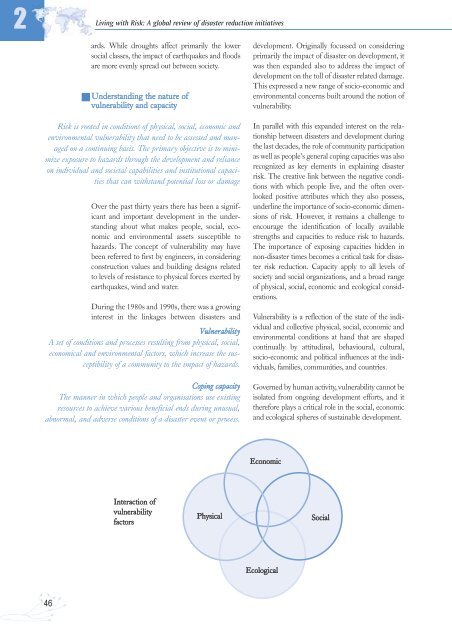A global review of disaster reduction initiatives - Welcome to the ...
A global review of disaster reduction initiatives - Welcome to the ...
A global review of disaster reduction initiatives - Welcome to the ...
You also want an ePaper? Increase the reach of your titles
YUMPU automatically turns print PDFs into web optimized ePapers that Google loves.
2Living with Risk: A <strong>global</strong> <strong>review</strong> <strong>of</strong> <strong>disaster</strong> <strong>reduction</strong> <strong>initiatives</strong>ards. While droughts affect primarily <strong>the</strong> lowersocial classes, <strong>the</strong> impact <strong>of</strong> earthquakes and floodsare more evenly spread out between society.Understanding <strong>the</strong> nature <strong>of</strong>vulnerability and capacityRisk is rooted in conditions <strong>of</strong> physical, social, economic andenvironmental vulnerability that need <strong>to</strong> be assessed and managedon a continuing basis. The primary objective is <strong>to</strong> minimizeexposure <strong>to</strong> hazards through <strong>the</strong> development and relianceon individual and societal capabilities and institutional capacitiesthat can withstand potential loss or damageOver <strong>the</strong> past thirty years <strong>the</strong>re has been a significantand important development in <strong>the</strong> understandingabout what makes people, social, economicand environmental assets susceptible <strong>to</strong>hazards. The concept <strong>of</strong> vulnerability may havebeen referred <strong>to</strong> first by engineers, in consideringconstruction values and building designs related<strong>to</strong> levels <strong>of</strong> resistance <strong>to</strong> physical forces exerted byearthquakes, wind and water.During <strong>the</strong> 1980s and 1990s, <strong>the</strong>re was a growinginterest in <strong>the</strong> linkages between <strong>disaster</strong>s andVulnerabilityA set <strong>of</strong> conditions and processes resulting from physical, social,economical and environmental fac<strong>to</strong>rs, which increase <strong>the</strong> susceptibility<strong>of</strong> a community <strong>to</strong> <strong>the</strong> impact <strong>of</strong> hazards.Coping capacityThe manner in which people and organisations use existingresources <strong>to</strong> achieve various beneficial ends during unusual,abnormal, and adverse conditions <strong>of</strong> a <strong>disaster</strong> event or process.development. Originally focussed on consideringprimarily <strong>the</strong> impact <strong>of</strong> <strong>disaster</strong> on development, itwas <strong>the</strong>n expanded also <strong>to</strong> address <strong>the</strong> impact <strong>of</strong>development on <strong>the</strong> <strong>to</strong>ll <strong>of</strong> <strong>disaster</strong> related damage.This expressed a new range <strong>of</strong> socio-economic andenvironmental concerns built around <strong>the</strong> notion <strong>of</strong>vulnerability.In parallel with this expanded interest on <strong>the</strong> relationshipbetween <strong>disaster</strong>s and development during<strong>the</strong> last decades, <strong>the</strong> role <strong>of</strong> community participationas well as people’s general coping capacities was alsorecognized as key elements in explaining <strong>disaster</strong>risk. The creative link between <strong>the</strong> negative conditionswith which people live, and <strong>the</strong> <strong>of</strong>ten overlookedpositive attributes which <strong>the</strong>y also possess,underline <strong>the</strong> importance <strong>of</strong> socio-economic dimensions<strong>of</strong> risk. However, it remains a challenge <strong>to</strong>encourage <strong>the</strong> identification <strong>of</strong> locally availablestrengths and capacities <strong>to</strong> reduce risk <strong>to</strong> hazards.The importance <strong>of</strong> exposing capacities hidden innon-<strong>disaster</strong> times becomes a critical task for <strong>disaster</strong>risk <strong>reduction</strong>. Capacity apply <strong>to</strong> all levels <strong>of</strong>society and social organizations, and a broad range<strong>of</strong> physical, social, economic and ecological considerations.Vulnerability is a reflection <strong>of</strong> <strong>the</strong> state <strong>of</strong> <strong>the</strong> individualand collective physical, social, economic andenvironmental conditions at hand that are shapedcontinually by attitudinal, behavioural, cultural,socio-economic and political influences at <strong>the</strong> individuals,families, communities, and countries.Governed by human activity, vulnerability cannot beisolated from ongoing development efforts, and it<strong>the</strong>refore plays a critical role in <strong>the</strong> social, economicand ecological spheres <strong>of</strong> sustainable development.EconomicInteraction <strong>of</strong>vulnerabilityfac<strong>to</strong>rsPhysicalSocialEcological46

















